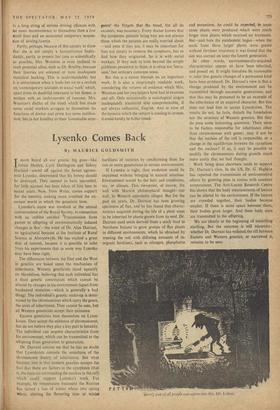Lysenko Comes Back
By MAURICE GOLDSMITH T HAVE heard all our genetic big guns—like 'Julian Huxley, Cyril Darlington and Sidney Harland—sound off against the Soviet agrono- mist Lysenko, determined that his heresy should be destroyed. They seemed to have succeeded, for little account has been taken of him here in recent years. Now, from Wales, comes support for the heretics, making more troubled the un- certain world in which the geneticist lives.
Lysenko's name was involved at the annual conversazione of the Royal Society, in connection with an exhibit entitled "'Transmission from parent to offspring of environmentally induced changes in flax'—the work of Dr. Alan Durrant, an agricultural botanist at the Institute of Rural Science at Aberystwyth. He has excited a great deal of interest, because it is possible to infer 'rum his experiments that in some way Lysenko may have been right.
The differences between the East and the West in genetics are based upon the mechanism of inheritance. Western geneticists stand squarely Mendelism, believing that each individual has a fixed genetic constitution which cannot be altered by changes in his environment (apart'from haphazard mutation—which is generally a bad thing). The individual's genetic make-up is deter- mined by the chromosomes which carry the genes, the units of inheritance. They cannot be seen, but all Western geneticists accept their existence.
Eastern geneticists base themselves on Lysen- koism. They accept the existence of chromosomes, but do not believe they play a key part in heredity. The individual can acquire characteristics from his environment, which can be transmitted to the Offspring from generation to generation.
Dr. Durrant assures me that he has no doubt that Lysenkoists concede the soundness of the chromosome theory of inheritance. But what interests him is that modern genetics accepts the fact that there are factors in the cytoplasm (that is, the material surrounding the nucleus in the cell) which could support Lysenko's work. For example, by temperature treatment the Russian has turned a line of winter wheat into spring Wheat, altering the flowering time or winter hardiness of varieties by conditioning them for one or more generations in certain environments.
If Lysenko is right, then evolution could be explained without bringing in natural selection. Environment would be the key; soil conditions, say, or climate. This viewpoint, of course, fits well with Marxist philosophical thought—too well, its Western opponents alleged. But for the past six years, Dr. Durrant has been growing specimens of flax, and he has found that charac- teristics acquired during the life of a plant seem to be inherited by plants grown from its seed. Dr. Durrant used seeds derived from a stock bred in Northern Ireland to grow groups of flax plants in different environments, which he obtained by treating the soil with differing amounts of in- organic fertilisers, such as nitrogen, phosphorus and potassium. As could be expected, in some cases plants were produced •which were much larger than plants which received no treatment. But—and here the puzzlement began—when the seeds from these larger plants were grown without fertiliser treatment it was found that the size was carried on unto the fourth generation.
In other words, environmentally-acquired characteristics appear to have been inherited, and passed on. It might therefore be reasonable to infer that genetic changes of a permanent kind have been produced. Dr. Durrant's view is that a change produced by the environment can be transmitted through successive generations; and that this may be presumed to be an example of the inheritance of an acquired character. But this does not lead him to accept Lysenkoism. The results do not, he feels, disturb the foundation nor the structure of Western genetics. But they do pose some interesting questions. There seem to be factors responsible for inheritance other than chromosomes with genes: may it not be that the nucleus of the cell is responsible, or a change in the equilibrium between the cytoplasm and the nucleus? If so, it may be possible to modify the chromosomes during growth much more easily that we had thought.
Work being done elsewhere tends to support Dr. Durrant's view. In the US, Dr. G. Highkin has reported the transmission of environmental effects by growing peas in rooms with constant temperatures. The Anti-Locust Research Centre has shown that the body measurements of locusts can be altered by the environment. If the locusts are crowded together, their bodies become smaller. If there is more space between them, their bodies grow larger. And these body sizes are transmitted to the offspring.
We are clearly at the beginning of something startling, But the outcome is still uncertain : whether Dr. Durrant has widened the rift between Eastern and Western genetics, or narrowed it, remains to be seen.
'Surely yOu of all people can appreciate this, Mr. Lehrer.'






































 Previous page
Previous page